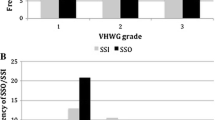Abstract
Purpose
BMI > 40 kg/m2 and smoking have been identified as risk factors for surgical site infections (SSIs) after ventral hernia repair, however, the relationship with lower BMI values has not been described. The objective of this study was to analyze the relationship between different BMI thresholds, smoking, and SSI after open ventral hernia repair.
Methods
All patients who underwent an elective non-emergent open ventral hernia repair with mesh were extracted from the 2011 to 2016 NSQIP database. Bivariate, multivariate logistic regression, and Classification and Regression Tree (CART) analyses were used.
Results
Of 55,240 patients, 2,620 (4.7%) developed SSIs (superficial: 58.5%, deep:27%, organ–space: 16%). BMI (OR: 1.035; 95% CI:1.03–1.04; p < 0.001) and smoking (OR:1.51; 95% CI:1.37–1.67; p < 0.001) were identified in logistic regression analysis as the two most modifiable risk factors independently associated with SSIs. CART analysis demonstrated that the lowest SSI rate belonged to non-smokers with BMI < 24.2 kg/m2 (1.9%), and the highest SSI to smokers with BMI > 42.3 kg/m2 (12%). Between these values, there was a stepwise increase in SSI rate as BMI increased, while smoking added additional risk in each group.
Conclusion
Following open hernia repair, the association between SSI and being overweight starts at a BMI of 24.2, a threshold lower than previously described. The risk of SSI increases in a stepwise fashion as BMI increases and is augmented by smoking. Future studies are needed to determine if SSI reduction can be achieved with a combination of smoking cessation and weight loss using these BMI thresholds.

Similar content being viewed by others
Data availability
NSQIP data is available to all participants in the program.
References
Poulose BK, Shelton J, Phillips S et al (2012) Epidemiology and cost of ventral hernia repair: making the case for hernia research. Hernia 16:179–183
Merkow RP, Ju MH, Chung JW et al (2015) Underlying reasons associated with hospital readmissions following surgery in the United States. JAMA 313:483–495
Holihan BL, Alawadi ZM, Martindale RG et al (2015) Adverse events after ventral hernia repair: the vicious cycle of complications. J Am Coll Surg 221:478–485
Dunne JR, Malone DL, Tracy JK, Napolitano LM (2003) Abdominal wall hernias: risk factors for infection and resource utilization. J Surg Res 111:78–84
Finan KR, Vick CC, Kiefe CI et al (2005) Predictors of wound infection in ventral hernia repair. Am J Surg 190:676–681
Lindstrom D, Sadr A, Wladis A et al (2008) Effects of perioperative smoking smoking cessation intervention on postoperative complications: a randomized trial. Ann Surg 248:739–745
Berger RL, Li LT, Hicks SC et al (2013) Development and validation of a risk-stratification score for surgical site occurrence and surgical site infection after ventral hernia repair. J Am Coll Surg 217:978–984
Regner JL, Mrdutt MM, Munoz-Maldonado Y (2015) Tailoring surgical approach for elective ventral hernia repair based on obesity and National Surgical Quality Improvement Program outcomes. Am J Surg 210:1024–1029
Liang MK, Holihan JL, Itani K, Alawadi ZM (2017) Ventral hernia management expert consensus guided by systematic review. Ann Surg 265:80–89
Morgan, J. Classification and Regression Tree Analysis. Technical Report No. 1. https://www.bu.edu/sph/files/2014/05/MorganCART.pdf. Accessed 25 Nov 2018.
Halm JA, Heisterkamp J, Veen HF, Weidema WF (2005) Long-term follow-up after umbilical hernia repair: are there risk factors for recurrence after simple and mesh repair. Hernia 9:334–337
Cherla DV, Holihan JL, Flores-Gonzalez JR, Lew DF (2017) Decreasing surgical site infections after ventral hernia repair: a quality-improvement initiative. Surg Infect (Larchmt) 18:780–786
Stey AM, Russell MM, Sugar CA, Hall BL (2015) Extending the value of the National Surgical Quality Improvement Program claims dataset to study long-term outcomes: Rate of repeat ventral hernia repair. Surgery 157:1157–1165
Novitsky YW, Porter JR, Rucho ZA et al (2006) Open preperitoneal retrofascial mesh repair for multiply recurrent ventral incisional hernias. J Am Coll Surg 203:283–289
Monfrecola G, Riccio G, Saverese C et al (1998) The acute effect of smoking on cutaneous microcirculation blood flow in habitual smokers and nonsmokers. Dermatology 197:115–118
Moller AM, Villebro N, Pederson T, Tonnesen H (2002) Effect of preoperative smoking intervention on postoperative complications: a randomized clinical trial. Lancet 359:114–117
Sorensen LT, Karlsmark T, Gottrup F (2003) Abstinence from smoking reduces incisional wound infection: a randomized controlled trial. Ann Surg 238:1–5
Sorenson LT (2012) Wound healing and infection in surgery. The clinical impact of smoking and smoking cessation: a systematic review and meta-analysis. Arch Surg 147:373–383
Thomsen T, Villebro N, Moller AM (2014) Interventions for preoperative smoking cessation. Cochrane Database Syst Rev 3:CD002294
Jencks SF, Williams MV, Coleman EA (2009) Rehospitalization among patients in the Medicare fee-for-service program. N Engl J Med 360:1418–1428
Funding
No funding was received.
Author information
Authors and Affiliations
Corresponding author
Ethics declarations
Conflict of interest
The authors have no disclosures.
Ethical approval
This study was approved by the Los Angeles Biomedical Institute Institutional Review Board as a non-human study.
Research involving human participants and/or animals
This study does not involve human participants or animals.
Informed consent
Informed consent was not required in this study.
Additional information
Publisher's Note
Springer Nature remains neutral with regard to jurisdictional claims in published maps and institutional affiliations.
NSQIP Disclosure: The American College of Surgeons National Surgical Quality Improvement Program and the hospitals participating in the ACS NSQIP are the source of the data used herein; they have not verified and are not responsible for the statistical validity of the data analysis or the conclusions derived by the authors.
Rights and permissions
About this article
Cite this article
Park, H., de Virgilio, C., Kim, D.Y. et al. Effects of smoking and different BMI cutoff points on surgical site infection after elective open ventral hernia repair. Hernia 25, 337–343 (2021). https://doi.org/10.1007/s10029-020-02190-x
Received:
Accepted:
Published:
Issue Date:
DOI: https://doi.org/10.1007/s10029-020-02190-x




